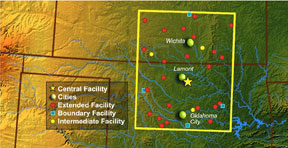High-Speed Internet Deflects Information Overload
Published: 30 November 2007

A little more room in the internet link at the ARM Southern Great Plains site is providing needed relief to the crowded lines that keep data flowing from the site. In July 2007, the internet service from the SGP Central Facility was switched to a higher speed (6 megabits) link, increasing the bandwidth by almost four times and providing a significant cost savings. In addition, a number of SGP extended facilities, boundary facilities, and intermediate facilities have been converted from dial-up connections to digital subscriber lines to improve both bandwidth and reliability.
Established in 1992, the SGP site remains the flagship ARM site, with the most instruments and the longest data record. Continued increases in data flowing through the SGP Central Facility began approaching the critical limits of the original bandwidth. Recognizing the need for faster data transfer to keep the lines from bogging down, ARM operations staff pursued new internet services for this critical component of the site data system. Cost savings was achieved by moving from an offsite T1 connection to a local internet provider. The physical length of the original T1 service line contributed significantly to its higher cost.
Internet access to and from the site was disrupted for only a few hours as the new routing mechanism propagated through the internet; a small price to pay for a smooth-running infrastructure. Infrastructure at the SGP Central Facility will now support a 20-megabits link, if needed, for future instrument enhancements. Operations personnel continue to monitor the availability of more cost efficient network connectivity for those extended and intermediate facilities still on dial-up links.
The ARM Climate Research Facility is a DOE Office of Science user facility. The ARM Facility is operated by nine DOE national laboratories, including .
Keep up with the Atmospheric Observer
Updates on ARM news, events, and opportunities delivered to your inbox
ARM User Profile
ARM welcomes users from all institutions and nations. A free ARM user account is needed to access ARM data.


















